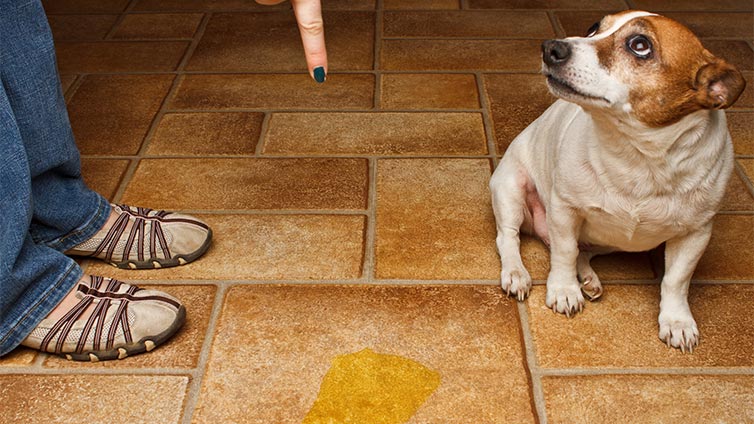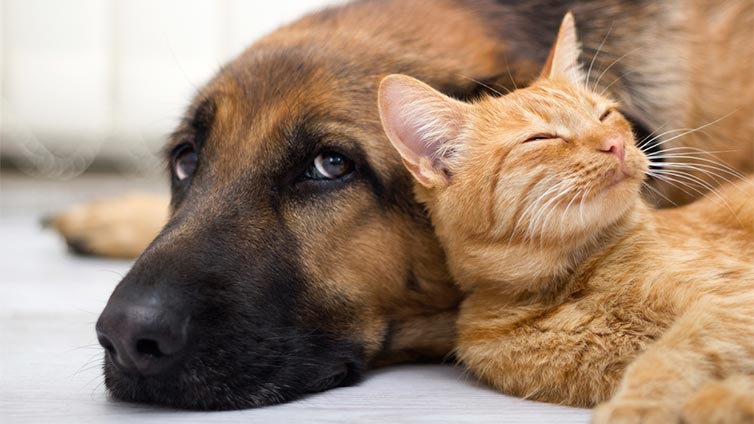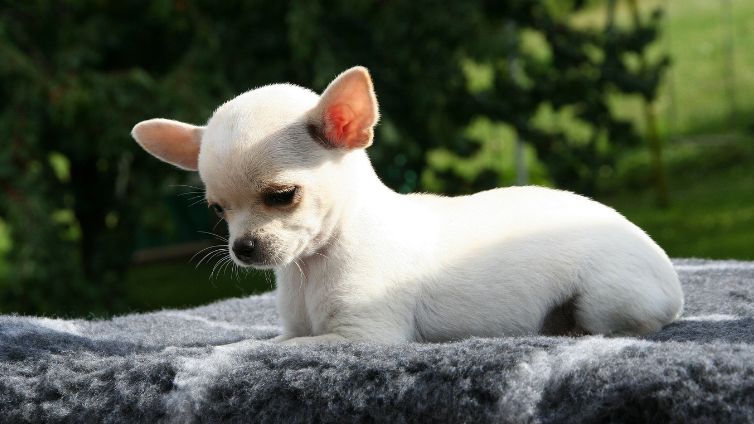In order to understand which places are OK to urinate and defecate on and which under any circumstances are not, you need to guide your dog through a simple training process.
As with any other, it takes time, patience and consistency in method, but also close supervision in the beginning and a regular schedule that will make the learning process much easier.
Since this potty training isn’t a typical training process, in the beginning, avoid any punishment, since young puppies’ reaction to the fear caused by punishment may just be urinating or defecating – again.
Before telling you more about how to properly potty train your puppy, you and your home should first be prepared for a new furry family member. It’s important to go through the new puppy checklist and make sure you have all the equipment that is needed in the process of your pup’s physical development, but some items will also make it much easier for you to train your pup and bond with him earlier.
When To Start Potty Training?
The very first training task that jumps in front of the fresh dog owner is “how to teach the dog where to pee?” How is it even possible that such a cute, small creature as your puppy can make all that mess?
First of all, puppies under twelve weeks haven’t gained the full bladder control yet, so they simply have to do it the moment they feel like urinating. Even a few weeks after this age, they aren’t really able to hold it for very long.
So, if your puppy is this young, start the training from the day one, but be super-patient. At that age, it is not only a matter of your doggy’s will to cooperate but also a matter of physiological development. Nevertheless, no matter how old your puppy is, you should start the training as early as possible.
Are Puppy Potty Pads Good or Bad?
When we use the phrase “puppy potty pad”, we think of a certain interchangeable cover that your dog will urinate and defecate on. The pet products market provides with several types of products of this kind: absorbent potty pads also known as puppy pads or pee-pee pads, dog litter boxes and trays lined with an artificial turf, but several sheets of newspaper (that you would change regularly during the process) have been known to do the trick just fine. The answer to the question “Are puppy potty pads good or bad” is not as simple as “yes“ or “no”, since it depends mostly on you deciding what kind of rules you would like to establish. Nevertheless, puppy potty pads are most certainly useful as a tool in the learning process.
When are puppy potty pads good?
- During the teaching/training process
- If you intend to permanently allow your dog to urinate and defecate in the indoor area you decide on
- If you are absent for too long to expect the dog to wait until you get back and take him out
When are puppy potty pads bad?
- If you decide that urinating and defecating anywhere indoor is unacceptable, and the training process isn’t completed yet. At this point where your dog begins to understand what is to be done where, keeping the potty pad in sight may only cause confusion. Sure, sometimes a half-trained dog can make a mistake, but it is less of a problem than actually creating a situation in which the presence of a puppy potty pad makes going out seem optional
Training Strategies
Depending on whether your goal is to train the dog to use the potty pad or to train him to soil outside, training strategies will take different courses.
Train Your Dog To Use The Potty Pad Permanently
The beginning of every where-to-pee-and-poop training requires not only your presence but also keeping your puppy in sight.
Urinating and defecating are predictable if you maintain the rhythm of the activities, for example feeding. Activities that are likely to be followed by peeing and pooping are feeding, drinking water, playing and waking up.
By monitoring these activities, you will be able to predict when the time is right to take your puppy to the potty pad. Sure, sometimes your timing might not be perfect and you may miss, but repeating this routine regularly will create the link between the urge to urinate or defecate and doing that in a particular place.
Keep in mind that very young puppies sometimes simply cannot hold it in, so do not punish a semi-successful attempt of reaching for the potty pad. Encourage the puppy, even if the task is not fulfilled, it is a sign of progress.
It’s important to keep in mind that length of this process varies from puppy to puppy, sometimes it takes only several attempts until it is clear – sometimes it takes several weeks. Be patient and do not change the routine!
Train Your Dog To Do It Outside
First steps of this strategy depend on your puppy’s age. If your puppy is too young to be taken outside, it begins the same way as the strategy we have previously written about. You monitor your puppy’s activities and react accordingly, by taking the puppy to the potty pad.
Later, when your puppy is old enough to be taken or carried outside, by monitoring the activities we mentioned earlier (eating, drinking water, playing, waking up) you will be able to recognize the pattern of behavior and know when the time is right to take the puppy outside.
Be sure that you will not always be able to predict precisely and that “accidents” will most certainly happen. Therefore, keep the potty pad or several sheets of news paper within your reach, for a short period of the transitional period.
How To Get The Dog Urine Out Of The Carpet?
Aside from the strategy you hold onto in the matter of training your puppy, another strategic question occurs – a cleaning strategy. Cleaning after your still untrained puppy especially if you are not particularly prepared for the magnitude of the “disaster” may become an exhausting job.
Therefore, keeping the “quick cleaning kit” close at all times sure does come handy. It should at least contain a newspaper, paper towels and a sponge.
How to get the dog urine out of the carpet is a very common question, especially when it comes to first-time puppy owners.
Cleaning The Freshly Soiled Area
When you spot the fresh urine stain or even catch the perpetrator in the act.
Taking the fresh stain out of the carpet and getting rid of the odor is far less difficult than spotting and cleaning the old one.
If you’ve caught the perpetrator in the act, make sure that you loudly express discontent and then proceed to cleaning the mess. First use paper towels, a newspaper or some other absorbent material to dry the soiled place as much as possible.
How dry you can get it depends also on the type of the carpet you have. Ironically, the better quality carpet – the harder it is to clean. Put pressure on the soiled spot with an absorbent material for a few minutes in order to dry the deeper layers of the carpet.
After you dried it as much as possible, use a sponge and water to clean the spot. There are different opinions on whether to use some cleaning agent or not. An argument commonly used against it is that the scent of the agent will provoke the dog to soil the same place again.
This is not entirely true; you may use a cleaning agent, but try sticking to those you regularly use in your household, for example use the same product you use to clean the carpet on a regular basis.
It is though true that using agents with a very strong scent, especially those you do not regularly use (such as vinegar, alcohol or some other strong scented cleaning agents) and that your dog is not used to may come as a challenge or an invitation to overpower with the smell of his own.
This game of scent overpowering may turn your carpet into an unwanted puppy potty area, so try to avoid it by all means.
The pet products market as well as the cleaning products industries provide us also with products designed specifically for the use of this sort.
Cleaning The Old Urine Stains
Cleaning the soiled carpets or furniture is a bit harder when urine has dried out. You will most definitely be able to smell the odor and by following your nose you will be able to find the particular spot.
The importance of cleaning it beyond recognition lays in the behavioral pattern some dogs display: Some of them keep coming back and pee on the particular spot in the house that they recognize as the potty area because of the urine traces presence.
To make potty training easier, learn how often puppies need to pee – this way you will be better prepared.
Therefore, try cleaning it to the best of your abilities. Clean the spot with an agent you usually use to clean your carpets so that the smell does not become an invitation for the “whose smell is stronger” game.
After cleaning with the agent, do it all over again with just clean water. An option that is also recommendable is to use some of the cleaning products that have no smell at all.
After cleaning, dry the wet area well.
Good to know: If you miss cleaning urine stains completely, your dog might pee in his crate frequently
Common mistakes in cleaning the soiled area
- Do not use a steam cleaner. Although it may seem to be the logical choice, the steam will pull the urine traces to the top layer of the carpet or of some other part of furniture, and keep them “in plain sight” for your dog to return to for another round. You may use it, though, as a first step, but afterwards use the cleaning product you regularly use and water to clean it all over again
- Do not use strong scent cleaning agents and expect that their smell will mask and overpower the urine odor. Your dog will still be able to smell it
- Do not leave old urine stains be, just because you cannot see them – if you can smell them, so can your dog. It is even more important if you keep more than one dog in your household
Outside Potty Area
Training your dog to pee and poop outside the house is a training task that goes hand in hand with teaching him where not to do it in the house. The approach to the training depends on the goals you want to achieve as well as on where you keep your dog.
If the goal of the training is to teach the dog to soil outside, with no restrictions or no particular areas you attempt to aim the action at, you simply stick to the established strategy which you basically started inside the house by monitoring puppy’s activities and taking him outside when you predict that the time is right.
If the goal is to establish a particular outside area where soiling is acceptable and you have already started with the indoor training, the only difference between this strategy and the previous one is that, in this case, you take your dog by the leash to the specific area.
The situation is a bit different when it comes to training the puppy who lives outdoors. Dogs instinctively do not soil where they sleep and eat. If by not paying enough attention and not allowing the dog to release elsewhere and soiling on the mentioned places becomes the routine, it is nearly impossible to potty train the dog.
If you keep the dog outside, monitor dogs activities just like explained in previous two examples, and take him to the place that you decided to be the potty area.
As well as the indoor training, outdoor potty training takes time and patience. Usually, the time needed for the puppy to fully understand what is to be done where is between a month and two months. Try not to confuse the puppy by changing the rules or the goals of the training.
Being consistent with the rules you once established makes the learning process much quicker and less unpleasant and frustrating for you as well as for your puppy.
Don’t forget to reward the job well done, but don’t be too hard on punishing the puppy when mistakes occur.





















